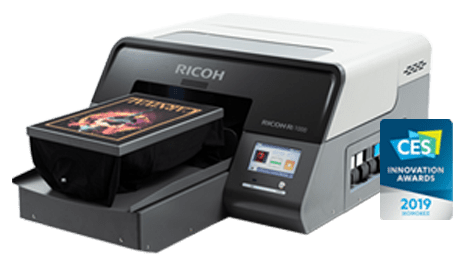
Brother GTX Garment Printer Review
Paul Boody

Benefits of DTG
With Brother’s DTG printer, the GTX, you get all of the traditional benefits of our direct to garment printers plus an expanded offering of additional features and benefits you’ll only find with the GTX.
The Brother GTX comes with technical sophistication and ease of use that you would expect from the next generation of garment printers plus more. With the Brother GTX Garment printer and ink, print the most complicated and color-intense designs (including photographic imagery) faster and with more eye-popping resolution faster than ever before.
Do More with DTG Printing
Let technology take the place of costly labor and lengthy skills training. With DTG printing, a single person can take an order, print the items and prep everything for delivery before quickly moving on to the next job.
- Unlimited color options and design reproduction
- Efficient short runs and one offs
- Quick and easy reprints
- Faster output and response to market trends
- Seamless printing over zippers and other difficult garments
- Reduced labor and training requirements
- Easier set up and smaller space requirements
Step 1 – Pretreat and Cure the Garment
When printing with white ink, apply the proper amount of pretreat depending on the garment preferably with a Brother-recommended pre-treatment machine for optimal results. Then simply cure the pretreat solution with either a heat press or dryer to ensure a flat printing surface.
Step 2 - Prepare the Digital Art
Load your artwork into our new graphics software GTX Graphics Lab Software. GTX Graphics Lab allows you to position the image, add text, distress layers and make other adjustments to your image before sending the file to print using the GTX print driver. Optionally, you can also print directly from your own graphics software.
Step 3 – Printing on the Garment
Dress the platen with your desired garment or substrate and press print.
Step 4 – Cure the Ink on the Garment
Place the printed garment on to the heat press once again or in a forced air dryer to cure the ink. This will ensure the ink is fully cured to the garment and will have the desired washability.
Technical Specs
Printing Method
Machine Size
55"(W) x 51"(D) x 21"(H) (1400mm x 1290mm x 535mm)
Platen Sizes
Maximum print size is 16" x 21" / 40,6cm x 53,3cm
Ink Type
Ink-Head Type
On-demand piezo head
Number of Ink-Heads
2 print heads / 8 ink channels
Print Resolution
1200 dpi x 1200 dpis
Print Mode
Single or double for CMYK. Underbase and highlight for white.
ENVIRONMENT
Data Output
Printer driver (USB, File output)
Power Supply
AC 100V-240V, 50/60Hz ± 1Hz
Power Consumption
0.8A (average) (Reference: 0.3A - during circulation)
Ink Cure
Heat press machine can be used at 356°F (180°C) and 35 seconds duration. For higher volume production, a conveyor oven is recommended to be used at 320° (160°) for three and a half minutes. Time and temperature may vary depending on which manufacturer's dryer is used.
Pre-Treatment
Before printing, apply pre-treatment using either a manual or automatic device and then dry garment using a heat-press, being sure to follow all manufacturer's instructions. Pre-treatment is necessary for white ink.
Software
OS
Windows® 7(32 bit/64 bit), Windows 8.1(32 bit/64 bit) , Windows 10(32 bit/64 bit), Mac OS® X v10.10.x
Interface
USB2.0, LAN(10 BASE-T, 100 BASE-TX), USB Flash Memory(Under 32GB, FAT32 format)
Driver Operating Conditions
2GHz CPU (minimum recommendation) 4GB RAM
Display Resolution
XGA (1024×768) (minimum recommendation)
Recommended Applications
CorelDRAW® X6/X7, Adobe® Photoshop CS6/CC, Adobe® Illustrator CS6/CC, Adobe® Photoshop Elements 12/13















